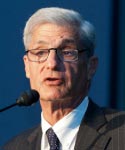Letter from the Chair & President
2010 marked 30 years of work for LISC helping to revitalize disinvested communities. And much has been accomplished over those three decades.
What began for us in 1980 as a creative way to rebuild the physical infrastructure of crumbling neighborhoods has grown into a broad, multifaceted effort designed to help low-income families build a better quality of life and for their neighborhoods to flourish in the process. We call it Building Sustainable Communities.
Certainly, the world has changed a great deal since those early days. Communities once given up for dead have, in fact, become good places to live, work, do business and raise families. You need only stroll down the streets in some of these places to see that.
What some might not recognize, though, is how much the mindset about poverty has also changed. Over the last 30 years, LISC and the entire community development field have proven that the right partners, the right financial tools, and the right policy framework can move low-income families and communities toward stability and growth. Even today, there is opportunity for even the most troubled places to move beyond their current struggles, just as so many have emerged from their disinvested pasts.
Consider how far we have come. LISC’s earliest local programs in places like New York City and Chicago were established amid wrenching dislocation in impoverished communities. We were facing the precipitous decline of traditional neighborhoods as primary points of connection…as the places that rooted families, businesses and institutions to economic opportunity, social stability and to each other.
Back then, top-down government programs could not reverse the slide. Individuals could not shift it. And motivated community groups were just barely nudging the needle forward, as most lacked the financial or organizational capacity to enact lasting change. For much of America, the idea of entrenched poverty became just another evening news norm, with blighted neighborhoods viewed as a reality largely beyond our control.
Except, it wasn’t beyond our control—not in 1980 when LISC made its first loan and not now. Today, we have a comprehensive community development strategy that puts more tools than ever at our disposal. We have a federal government increasingly focused on breaking down silos between programs affecting communities. We have a nationwide base of sophisticated community organizations with the experience and capacity to drive revitalization. And we have a wealth of experience gained from 30 years on the ground in what were once—and in some places continue to be—the most challenged communities in the country.
LISC’s 2010 performance illustrates that. We invested $1.1 billion in grants, loans and equity in new housing and improved schools, in innovative community safety programs and foreclosure mitigation efforts, and in family financial literacy and jobs. We helped spur economic development that revived commercial corridors with small entrepreneurial businesses as well as large retail and industrial employers. We supported new athletic fields, arts and entertainment facilities and community green space. We replaced environmentally contaminated eyesores with multi-purpose green development. And we promoted programs that brought healthy food to food deserts and health care services to places that had long gone without primary medical care. In 2010, we weren’t just investing in the built environment. We were investing in stability, opportunity and growth.
Most of that was not on our agenda in 1980. We were a housing organization, and that alone was a pretty daunting task at the time. Many of those same challenges remain, but now we are focused on the overall prosperity of struggling communities as well as that of the people who live there. The implications are significant. When low-income families have a chance to succeed, not only do they raise their own standards of living, they contribute to our national economic engine.
This year’s annual report details how that is happening in very different communities all across the country. We hope you take a minute to look through what we are doing with NeXT Neighborhoods in the San Francisco Bay Area or GO Neighborhoods in Houston or Our Neighborhoods in Rhode Island or other similar programs in any of the 30 urban localities and more than 70 rural communities where we work.
We don’t know for certain what the next 12 months will hold for LISC or for the places we work. We do know this: our financial position is as strong as it has ever been. Our loan portfolio is stable and performing. Our fundraising is solid and growing. The National Equity Fund, our Low Income Housing Tax Credit syndication arm, is investing record equity amounts and reinvesting half the net income it generates in LISC’s national efforts. And our New Markets Tax Credit business continues to aggressively pursue commercial development in high-need areas, with the largest New Markets allocation in the country.
In short, LISC has come through the economic downturn much as we have the last 30 years—energized, engaged and in a remarkably strong position. We are focused on helping the communities where we work do the same. On this point, we will give our friend Peter Goldmark—former head of the Rockefeller Foundation, former budget director of the state of New York and former head of the Port Authority of NY/NJ—the final word. In his keynote address at our recent 30th Anniversary Gala, he gave voice to the values that underpin healthy communities, and in doing so addressed both LISC’s history and our future:
“LISC understood from the beginning that the critical center of what it undertook was not bricks and mortar—bricks and mortar were the vehicle. What the vehicle nurtured and created was human cooperation, an ethic of responsibility and self-help, neighborhood values, and mutual obligations. Your Building Sustainable Communities initiative exemplifies that.”

Michael Rubinger, President & CEO

Robert E. Rubin, Chair

